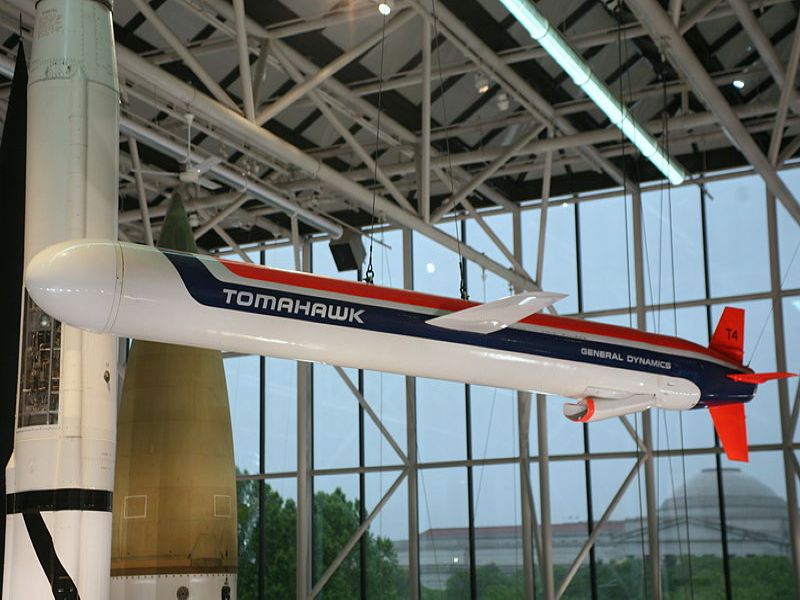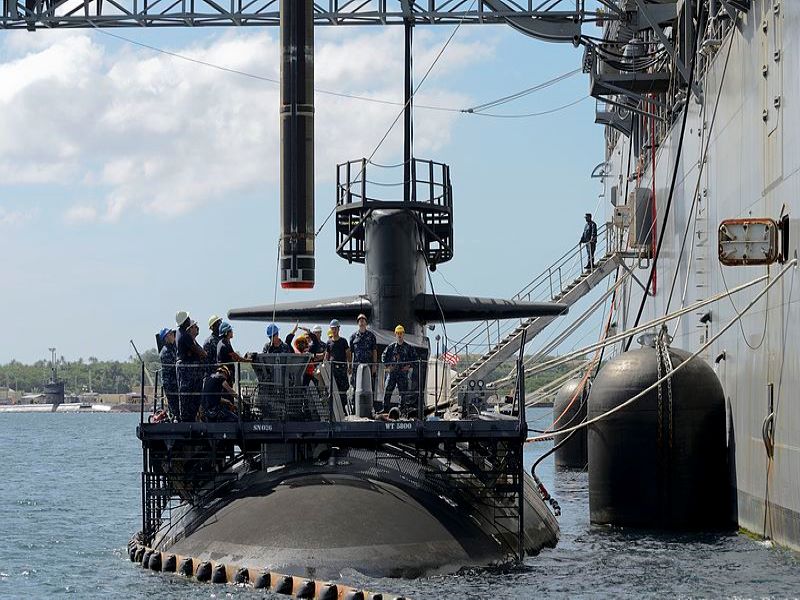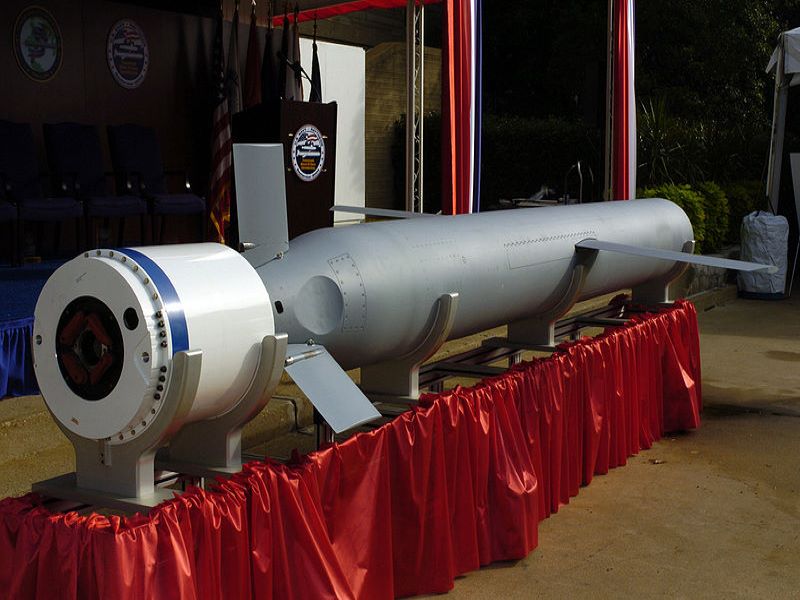Tomahawk is a long-range, all-weather, subsonic cruise missile in service with the surface ships and submarines of the US and the UK’s Royal Navy. Originally produced by General Dynamics, Tomahawk is currently manufactured by Raytheon.
The Tomahawk Land Attack Missile (TLAM) can strike high-value or heavily defended land targets. The Block II TLAM-A missile achieved initial operating capability in 1984. The missile was first deployed in combat during Operation Desert Storm in 1991.
Tomahawk missile variants
The Tomahawk family of missiles includes a number of variants, carrying different warheads. The UGM-109A Tomahawk (Block II TLAM-A) carries a W80 nuclear warhead.
RGM / UGM-109C (Block III TLAM-C) is a conventional unitary variant, carrying a 1,000lb-class warhead. RGM / UGM-109D (Block III TLAM-D) is a submunitions dispenser variant armed with 166 combined-effects bomblets.
RGM / UGM-109E Tomahawk (Block IV TLAM-E) is the latest member in the Tomahawk missile family. It carries a 1,000lb-class unitary warhead for a maximum range of 900nmi.
The Tomahawk Block IV missiles were converted and upgraded to Block V in 2017. The upgraded Tomahawk includes extended range, enhanced navigation and communication systems and modernised data-link radio.
The upgrades were performed at Raytheon’s Tucson, Arizona facility. The US Navy will use the upgraded Tomahawk cruise missiles beyond 2040. Raytheon was contracted to integrate the upgraded navigation and communication systems into the Block IV Tactical Tomahawk (TACTOM) missile in March 2020. The upgraded version is known as the Block V TACTOM.
The Block Va variants will be named Maritime Strike and have the capability of hitting a moving target. The Block Vb will feature the Joint Multi-Effects Warhead System.
Tomahawk design features
The Tomahawk is designed to operate at very low altitudes while maintaining high-subsonic speeds. Its modular design enables the integration of numerous types of warheads, guidance and control systems.
The missile carries a nuclear or conventional payload. It can be armed with a nuclear or unitary warhead or a conventional submunitions dispenser with combined-effect bomblets. The missile has a 5.56m length, 51.8cm diameter and a 2.67m wingspan. The weight of the missile is 1,315kg. It has a life span of 30 years.
The Tomahawk weapon system includes the Tomahawk missile, Theatre Mission Planning Centre (TMPC) / Afloat Planning System and the Tomahawk weapon control system (TWCS) for surface vessels or combat control system (CCS) for submarines.
Guidance and control
The Tomahawk Block IV uses GPS navigation and a satellite data-link to continue through a pre-set course. The missile can be reprogrammed in-flight to a new target.
The two-way satellite communications are used to perform post-launch mission changes throughout the flight. The on-board camera provides imagery of the target to the commanders before the strike.
The guidance system is assisted by Terrain Contour Matching (TERCOM). The Digital Scene Matching Area Correlation (DSMAC) system or GPS provide terminal guidance.
The Tactical Tomahawk Weapons Control System (TTWCS) integrated within the ship’s systems computes the path to engage targets. The system enables the planning of new missions on board the launch vessel. TTWCS is also used to communicate with multiple missiles for reassigning the targets and redirecting the missiles in flight.
The Block IV Tomahawk missile is outfitted with advanced electronic support measure (ESM) seeker in Block IV Tomahawk missile. Its joint multi-effects warhead enables the commander to control the blast.
Propulsion
The Tomahawk Block IV missile is powered by a Williams International F415 cruise turbo-fan engine and ARC MK 135 rocket motor. The propulsion provides a subsonic speed of 880km/h.
Tomahawk launch platforms
The missile can be launched from over 140 US Navy ships and submarines and Astute and Trafalgar class submarines of the Royal Navy. All cruisers, destroyers, guided missile and attack submarines in the US Navy are equipped with a Tomahawk weapons system.
US Navy launch platforms were modified to accommodate upgraded Tomahawk missile variants. Four Ohio class nuclear ballistic missile submarines were converted into cruise missile submarines for firing Tomahawk missiles. The Virginia class submarines and the Royal Navy Astute class submarines were also fitted with new vertical launch modules for Tomahawk missile.
Tomahawk orders and deliveries
The US signed a foreign military sales (FMS) agreement with the UK in 1995 to supply 65 Tomahawks for use with the Royal Navy nuclear submarines. The first batch of missiles was delivered in 1998.
The US Government approved an agreement in 2003 to deliver 65 Tomahawk Block IV missiles for the UK. In August 2004, the US Navy placed a $1.6bn multi-year procurement contract with Raytheon for 2,200 Tomahawk Block IV missiles.
Raytheon was awarded a $346m production contract for 473 Tomahawk Block IV cruise missiles in March 2006. The contract includes 65 submarine torpedo tube-launched missiles for the Royal Navy. The Block IV entered service with the Royal Navy in March 2008.
Raytheon was awarded a $207m-worth firm-fixed-price contract in March 2009 for 207 Tomahawk Block IV All-Up-Round (AUR) missiles.
The 2,000th Tomahawk Block IV missile was delivered to the US Navy in February 2010.
The US Navy placed a $338m contract with Raytheon in June 2012 for the delivery of 361 Tomahawk Block IV tactical cruise missiles. Another contract worth $254.6m was awarded for Tomahawk Block IV in the same year.
Raytheon delivered the 3,000th Tomahawk Block IV to the US Navy in January 2014 as part of the ninth Block IV production contract.
The US Navy awarded a $251m contract to Raytheon for the production and delivery of Tomahawk Block IV missiles for both the US Navy and Royal Navy in September 2014.
A $25.9m contract for Tomahawk missile composite capsule launching systems (C/CLS) was awarded in December 2014. The C/CLS is integrated with the nuclear-powered fast-attack submarines and nuclear-powered guided-missile submarines, allowing the missile to be launched from submarines.
Tomahawk Block IV missile demonstrated its moving target capability in tests conducted in February 2015.
Raytheon received a $122m contract from the US Navy in March 2015 for the production of 114 Tomahawk Block IV all-up round missiles. Raytheon conducted an active seeker test flight for the Tomahawk Block IV cruise missile in January 2016.
The 4,000th Tomahawk Block IV missile was delivered to the US Navy in August 2017. The US Navy warships and submarines launched 66 GPS-enabled Tomahawk missiles at Syrian chemical weapon facilities in 2018.
Raytheon planned to undertake recertification and modernisation programmes for Tomahawk Block IV missile in 2019 to add maritime strike capability and multiple-effects warhead upgrades to the missiles.
Raytheon received a $349m contract for phase two of the Maritime Strike Tomahawk Rapid Deployment Capability to improve the Tomahawk cruise missile system in August 2019. Work will be executed in various locations across the US until February 2023.




